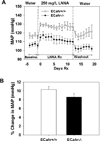Endothelial cell-specific aryl hydrocarbon receptor knockout mice exhibit hypotension mediated, in part, by an attenuated angiotensin II responsiveness
- PMID: 21684261
- PMCID: PMC3148414
- DOI: 10.1016/j.bcp.2011.06.011
Endothelial cell-specific aryl hydrocarbon receptor knockout mice exhibit hypotension mediated, in part, by an attenuated angiotensin II responsiveness
Abstract
Hypotension in aryl hydrocarbon receptor knockout mice (ahr(-/-)) is mediated, in part, by a reduced contribution of angiotensin (Ang) II to basal blood pressure (BP). Since AHR is highly expressed in endothelial cells (EC), we hypothesized that EC-specific ahr(-/-) (ECahr(-/-)) mice would exhibit a similar phenotype. We generated ECahr(-/-) mice by crossing AHR floxed mice (ahr(fx/fx)) to mice expressing Cre recombinase driven by an EC-specific promoter. BP was assessed by radiotelemetry prior to and following an acute injection of Ang II or chronic treatment with an angiotensin converting enzyme inhibitor (ACEi). ECahr(-/-) mice were hypotensive (ECahr(+/+): 116.1±1.4; ECahr(-/-): 107.4±2.0 mmHg, n=11, p<0.05) and exhibited significantly different responses to Ang II and ACEi. While Ang II increased BP in both genotypes, the increase was sustained in ECahr(+/+), whereas the increase in ECahr(-/-) mice steadily declined. Area under the curve analysis showed that Ang II-induced increase in diastolic BP (DBP) over 30 min was significantly lower in ECahr(-/-) mice (ECahr(+/+) 1297±223 mmHg/30 min; ECahr(-/-)(AUC): 504±138 mmHg/30 min, p<0.05). In contrast, while ACEi decreased BP in both genotypes, the subsequent rise in DBP after treatment was significantly delayed in the ECahr(-/-) mice. ECahr(-/-) mice also exhibited reduced vascular and adipose Ang II type 1 receptor (AT1R) expression, and reduced aortic Ang II-dependent vasoconstriction in the presence of vascular adipose. Taken together these data suggest that hypotension in ECahr(-/-) mice results from reduced vascular responsiveness to Ang II that is influenced by AT1R expression and adipose.
Copyright © 2011 Elsevier Inc. All rights reserved.
Conflict of interest statement
None
Figures








References
-
- McMillan BJ, Bradfield CA. The aryl hydrocarbon receptor sans xenobiotics: endogenous function in genetic model systems. Mol Pharmacol. 2007;72:487–498. - PubMed
-
- Vasquez A, Atallah-Yunes N, Smith FC, You X, Chase SE, Silverstone AE, et al. A role for the aryl hydrocarbon receptor in cardiac physiology and function as demonstrated by AhR knockout mice. Cardiovasc Toxicol. 2003;3:153–163. - PubMed
-
- Thackaberry EA, Gabaldon DM, Walker MK, Smith SM. Aryl hydrocarbon receptor null mice develop cardiac hypertrophy and increased hypoxia-inducible factor-1alpha in the absence of cardiac hypoxia. Cardiovasc Toxicol. 2002;2:263–274. - PubMed
-
- Walisser JA, Bunger MK, Glover E, Harstad EB, Bradfield CA. Patent ductus venosus and dioxin resistance in mice harboring a hypomorphic Arnt allele. J Biol Chem. 2004;279:16326–16331. - PubMed
MeSH terms
Substances
Grants and funding
LinkOut - more resources
Full Text Sources
Other Literature Sources
Medical
Molecular Biology Databases
Miscellaneous

